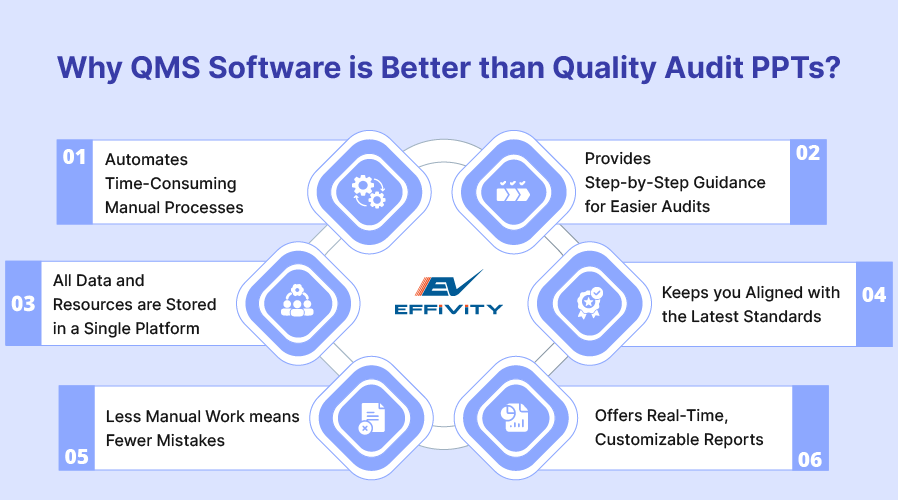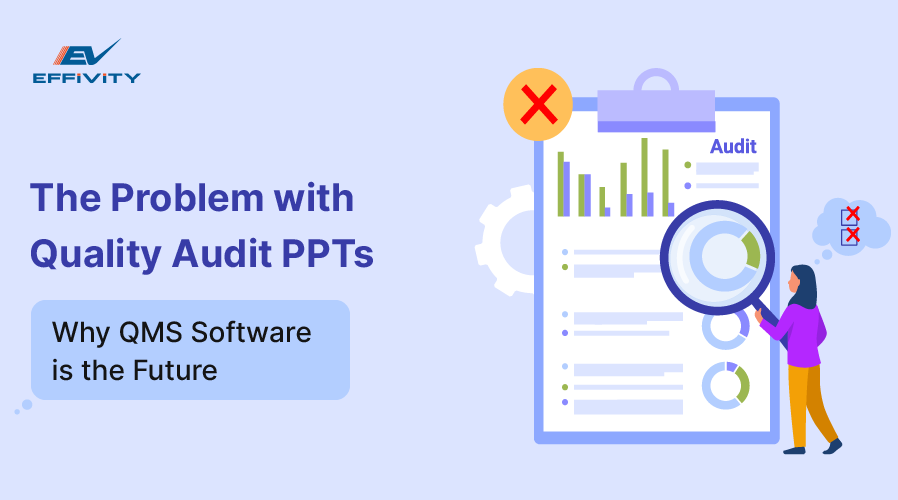If you’ve ever tried to manage or implement a quality audit using a bunch of slides, you know it can feel like trying to run a marathon in flip-flops.
Quality audit PPTs are useful for sharing information and teaching the basics, but when it comes to actually running an audit, PPTs fall short big time. And that’s where QMS software comes to the rescue.
In today’s blog, we’re diving into why relying on PPT for quality audits is like clinging to dial-up internet in a 5G world. Plus, we’ll talk about how QMS software is flipping the script by making quality audits not only easier but more foolproof.
Why Quality Audit PPTs Are Falling Short?
PowerPoint presentations can be a great way to learn foundational topics, but when it comes to advanced concepts like a quality audit, they aren’t the best tools out there.
So, if you’re watching the “qualities of an auditor” PPT, good. However, if you’re relying on PPTs to understand something complex like the quality audit process—that’s a big NO.
Here are some more reasons why quality audit PPTs aren’t cutting it:

1. Outdated Information
Quality standards and regulations are constantly evolving, and by the time you pull up a PPT to reference it, there’s a solid chance the information is outdated. This can leave you making decisions based on yesterday’s rules, which isn’t just risky but also inefficient.
2. Over-simplification of Complex Processes
Quality audits are complicated. Trying to boil them down into a few slides usually means important details get skipped. This can lead to misunderstandings or mistakes when it comes to the actual audit process.
3. Manual and Error-prone Implementation
With PPTs, you’re left translating static information into manual processes like feeding data, filling out forms, and cross-checking requirements. It’s all too easy to miss a step or misinterpret something along the way.
4. Lack of Practical Application Support
Sure, PPTs tell you what to do, but they don’t show you how to do it. You get the instructions, but when it’s actually time to take action, you’re left on your own to figure it out.
The Rise of QMS Software
Quality Management System (QMS) software is a tool that helps organizations manage, control, and improve the quality of their products, services, and processes.
Instead of relying on manual methods or piecing together information from PPTs, QMS software automates and centralizes these functions into a single platform.
So, while PowerPoints are great for giving you an overview (for example, “importance of a quality audit” PPT), QMS software takes that knowledge and turns it into action.
It actually helps you conduct audits more efficiently, track quality metrics in real time, manage non-conformances, and document corrective actions.
Key Advantages of QMS over PPTs
Let’s see how QMS software outshines PowerPoint presentations in key areas:

1. Efficiency and Automation
Quality audit PPTs might give you the “what,” but QMS software delivers the “how” with speed. Instead of wasting time scrolling through slides or manually updating audit details, QMS software automates tasks like scheduling audits, assigning roles, and tracking progress.
2. User-friendly for Beginners
QMS software guides through the audit process step by step, so you don’t need to be a pro to get it right. It’s like having a built-in mentor for your quality audits!
3. Centralized Knowledge Base
Forget flipping through slide decks to find what you need. QMS software centralizes all your knowledge management—policies, procedures, standards, and audit results into a single platform.
4. Compliance Assurance
QMS software is designed to follow industry standards and international regulations (like ISO 9001). Plus, with built-in compliance checks, you can be confident that your audits meet the latest standards without having to cross-check slides manually.
5. Error Reduction
Manual processes are prone to mistakes, especially when you’re relying on PPT slides and human memory to run an audit.
QMS software drastically cuts down on these errors by automating processes, ensuring consistency across all audits, and reducing the need for manual interventions.
6. Comprehensive Reporting
PPTs can show you static charts and data snapshots, but QMS software takes reporting to a whole new level. You can generate customizable reports that pull real-time data, highlight trends, and track performance over time using such software.
QMS Software: A Future-proof Solution
QMS software is more than just a stopgap solution. It’s a long-term investment in improving your quality management processes. Here’s how:
1. Scalability
Whether you’re a small business looking to expand or a large corporation with complex operations, QMS software can scale to meet your needs. It can expand right along with you, offering flexibility without extra burden.
PowerPoints, by contrast, can’t scale. They’re limited by the manual effort required to update and manage them.
2. Integration with Other Systems
QMS software isn’t just a standalone tool. You can integrate it with other systems like ERP, CRM, or communication tools. This kind of integration ensures that all your data flows together, so nothing is lost between systems.
PowerPoints, meanwhile, are isolated and don’t play nicely with other tools, forcing you to work in silos.
3. AI and Analytics Capabilities
QMS software is already leveraging AI and data analytics to provide deeper insights and predictive capabilities. They can identify potential risks before they become problems as well as spot trends across multiple audits.
PowerPoints? They can’t compete with the advanced data-driven insights that QMS software can offer.
Conclusion
While PPTs might be useful for learning the basics, they fall short when it comes to keeping up with today’s fast-paced working environments. And quality audits are too important to rely on outdated tools that can’t evolve with your needs.
QMS software offers a smarter, more efficient solution. It can automate tasks, reduce errors, provide real-time updates, and foster better collaboration.
As companies face increasing regulatory demands and aim for continuous improvement, QMS software is no longer a luxury but the future of quality management.





















